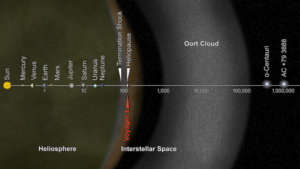NASA’s New Horizons spacecraft continues to speed away from the Sun and it is, at this moment, 6.4 billion km away from Earth, far beyond Pluto, but it has not sent in new data to the ground – it has measured what appears to be a wall of hydrogen.
In a nutshell, interstellar hydrogen gathers as it collides with the solar wind, which marks the edge of the Sun’s influence.
NASA used the Alice instrument on the New Horizons to take a 360-degree snapshot of ultraviolet emissions around the spacecraft, which showed an unusual, added brightness to the signal.
This is a close match to a measurement made by the Voyager some 30 years before. This information sent in from New Horizons, matched up to the Voyager’s measurements, gave the scientists new insight into what could just be the limits of our Sun’s reach.

The boundary of the solar system / NASA/JPL-Caltech
For now, NASA thinks the extra brightness could be there thanks to the hydrogen particles beyond our solar system or some other feature but the scientists are not sure what is the truth and would rather wait for more data to come in from the spacecraft.
The New Horizons is preparing to visit the Kuiper Belt Object 2014 MU69, which, as far as we know, is simply a 30Km-wide rock, and then the spacecraft will continue its quest toward the edge of the Solar System.
That edge is a place that is not so easily defined though. After the spacecraft will be away from the influence of solar wind, it still might have to pass the theorized Oort cloud, which is a sphere of icy comets that orbit the Sun. The outer limit of the cloud defines the comographical boundary of the Solar System and it is also easily affected by the gravitational pull of not only the passing starts but of the Milky Way itself.
The New Horizons is definitely in for a rough journey.
Meanwhile its older brother, the Voyager 1, is 11.7 billion miles away from Earth, escaping the solar system at 17 km per second with the help of multiple gravity assist boosters, and, by the time the two spacecraft will say hello to each other, most of us will most likely be long, long gone.
Voyager 1’s next encounter with a star though will be with the AC +79 3888, which lies 17.6 light-years from Earth. It will take the Voyager 40,000 years to reach it.
Follow TechTheLead on Google News to get the news first.





















